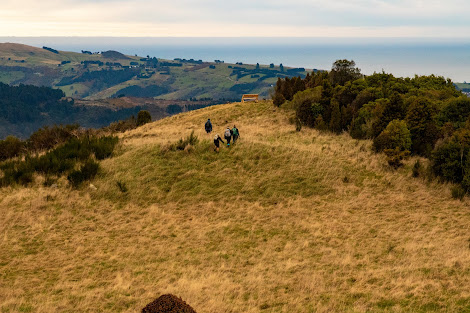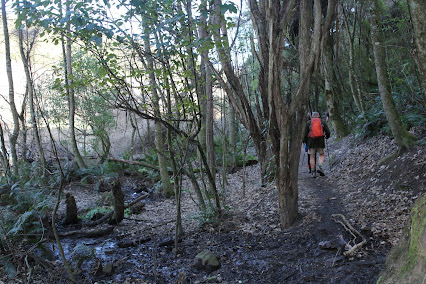Seven people turned up on a sunny winter's morning for a trip that was tipped to be one of the longer winter walks that we'd had for a while. Starting at Macandrew Bay, the walk around to Broad Bay was a very pleasant, easy hour around the flat cycle/walk way that skirts the edge of the Otago Harbour. The sun reflecting off the calm harbour waters made for a picturesque walk which passed very quickly. We were in for a rude awakening once we reached Broad Bay because this is where the up hill started and that was to be the theme for the rest of the day,ie: if we weren't going up, we were going down, . We headed up Camp Road towards Larnach Castle which is a steep 200m climb from sea level, starting on a gravel road and ending on a narrow, grassy trail. The higher we climbed the more the views opened out behind us and we were rewarded with a stunning vista looking across to Port Chalmers with Quarantine and Goat Island in the middle of the harbour.While the temperature was cool, the climb up the hill had warmed us and most had stripped off our jersey before we had reached halfway. Once we had climbed most of Camp Road we crossed into William Larnach's farm which he had purchased in the 1870's. In 2008 the Dunedin City Council bought the land and the Hereweka Harbour Cone Trust have developed a series of walking tracks through the land to allow public access to heritage sites on the property. We followed one of these tracks which took us past an historic cow byre which was built in 1880's and is the only remaining farm building left on Larnachs farm. We still had some height to gain to reach Highcliff Road but as often happens, there is always a down when going up and that is exactly what happened for us. We dropped almost 100m down through the, at times, boggy paddocks to cross the gully and then climb back out up to Highcliff Road. Despite loosing so much height, we were still reasonably fresh and it didn't take long to regain the height and reach Highcliff Road in good spirits.
The next part of our journey took us around Highcliff Road, dodging traffic for a couple of kilometres, turning off to have lunch at the historic lime kilns. It was here that the jersey's we'd taken off earlier were quickly put back on as we cooled down. It was good to refuel with lunch but knowing we still had a long way to go, we packed and headed down the road, turning off onto Ridge Road and continuing down to Sandfly Bay
While Sandfly Bay is a very popular beach for watching sea lions, the track from Ridge Road is not often used and we had the track to ourselves. After crossing from the gravel road into the paddock, we followed the fence line for around a kilometre, doding the muddy, boggy bits, until we reached the reserve and beach. Reaching the beach was a bit of a milestone as we had started at sea level and walked from one coast of the peninsula to the other - we were now half way. Despite there being a few sea lions on the beach, we continued on our way, skirting around the sand dunes before climbing 100m to the car park and continuing along the road, turning onto Braidwood Road. By now the feet and legs were starting to get a little tired, most likely from all the road walking but there was no choice but to continue and the beautiful coastal scenery surrounding us kept us upbeat as we began the descent back to sea level at Boulder Beach. No one wanted to take the 15 minute detour to the beach so we sheltered under a large tree for an afternoon snack and drink break, filling up on sugar in an effort to revive the energy levels for the final 300m climb up the Paradise track, back to Highcliff Road. The Paradise track is an unremarkable grassy climb for the first 100m before turning into a muddy, head high, flax tunnel for the next 100m. The gradient eases off for the final 100m but it's still muddy and slippery with attention being needed on foot placement to keep upright. It was a relief to reach Highcliff Road because there was no more climbing ahead of us - it was downhill all the way back to the car. We wandered along the edge of Highcliff Road till we reached the Greenacres track. I had never been down this track before and it was a bit of a surprise to see the steepness of it. Thankfully, for us, we were headed downhill and it was reasonably dry underfoot. Finding a swing on the steepest part of the track was a highlight and of course it had to be tested. By now, everyone was focused on reaching the end and we walked in ones and twos, bouyed by our achievement, happy when we finally reached the cars. The trip had been billed as 'all day on the peninsula' and it was with having walked 23.5km from one coast on the peninsula to the other coast and back to the first coast again, with over 900m of elevation gained and lost.















































.png)






